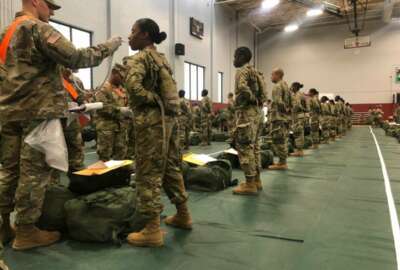
Army hits end strength goals despite COVID, but next year may be tough
Even with coronavirus completely upending the recruiting process, the Army still made the most of its adjusted 2020 recruiting goals and will be able to reach its...
Even with coronavirus completely upending the recruiting process, the Army still made the most of its adjusted 2020 recruiting goals and will be able to reach its required end strength. However, future years may have a tough road ahead.
By Oct. 1, the Army was supposed to bring its active duty numbers up to 485,000, its reserve to 189,500 and its National Guard numbers to 336,00.
Only the reserve numbers fell slightly short, coming in at 188,703.
Reaching end strength goals is a success for the Army after it had to completely transfer all of its recruiting operations virtual in March as the coronavirus struck the United States. Just a few years ago, the Army fell short of its recruiting goals, causing the service to take a hard look at how it marketed to youth.
“Thank goodness our retention rates were extremely high this year; we did very well with retention,” said Maj. Gen. Kevin Vereen, leader of Army Recruiting Command, during an Association of the United States Army event on Wednesday. “I can say that despite our reduction in our accessions mission, we still finished really high with quality marks.”
Vereen said he hopes to keep that momentum into 2021.
At the beginning of 2020, the Army planned on recruiting more than 65,000 soldiers. After coronavirus, the Army rethought what was possible and changed its goal to 62,150.
The question now is how much continued virtual recruiting and impacts of that lower 2020 recruiting numbers will effect end strength next year.
Back in June, then-leader of Recruiting Command, Maj. Gen. Frank Muth, said part of what helped the Army in the beginning of 2020 was a surplus of soldiers enlisting from the year before.
“As soon as we hit end strength and the secretary says, ‘Okay, that’s where I want to be’ That’s it,’” Muth said. “If it hits 485,000 and we’ve already assessed 63,000, we’re not going to go to 66,000 or 65,000 or 64,000. We’ll take those extra contracts and push them into the new year. We call that the debt pool, because that helps start the engine for the next year. We don’t want to exceed end strength at the end of the day because it’s a bill and we have to pay for it.”
The Army’s debt pool may not be as strong for 2021. However, there are still plenty of incentive programs to bolster end strength.
The Army created a short-term reenlistment extension for soldiers who were planning to leave the Army and wanted to stay in after the coronavirus pandemic hit.
“With the onset of COVID-19, some of our soldiers have now been faced with the reality that some opportunities are no longer available to them,” Sgt. Maj. Stuart C. Morgan, the Army’s senior career counselor, told Federal News Network. “We have an employment gap. We have multiple reenlistment options that can offer the soldier a new assignment or some type of training and also stabilization options.”
The Army’s virtual National Hiring Days and other online events helped bring in some 2021 recruits. The event ran for three days this summer and brought in several hundred contracts and 30,000 credible leads, Vereen said.
The Army has Operation Virtual Blitz coming in November and Operation Fresh Start will begin in early 2021, those are both pushes to bring in recruits for next year.
The service is also continuing its controversial esports stream, which broadcasts on Twitch and interacts with children online, as well as at gaming conventions when COVID-19 is not shutting down large gatherings.
“Our esports stream is just phenomenal,” Vereen said. ”We’ve had to kind of make some adjustments because we don’t have the mass events that we would have had in normal conditions. We’re still in the gaming tournaments and network through the virtual space.”
Copyright © 2025 Federal News Network. All rights reserved. This website is not intended for users located within the European Economic Area.
Scott Maucione is a defense reporter for Federal News Network and reports on human capital, workforce and the Defense Department at-large.
Follow @smaucioneWFED



